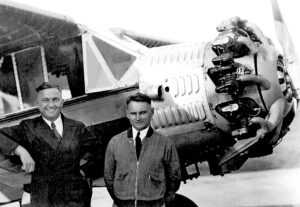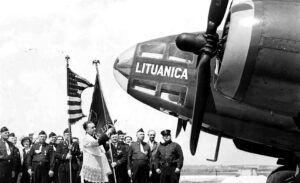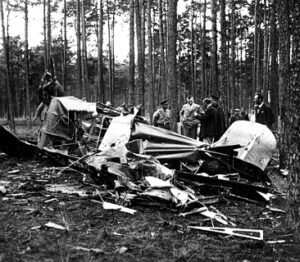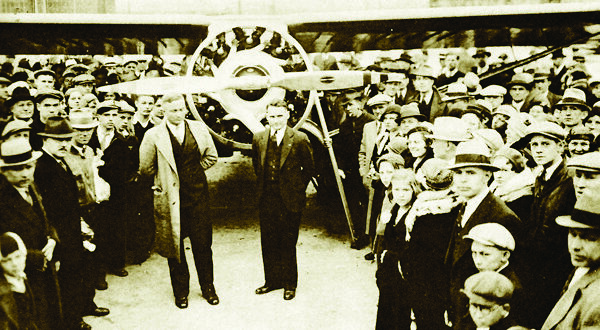Juozas Skirius.
Each summer, we recall the tragic fate of Steponas Darius and Stasys Girėnas, the two Lithuanian airmen who attempted a pioneering flight across the Atlantic. This event was widely covered by the media of its day and deeply impacted the Lithuanian community on both sides of the Atlantic. It is remembered as a testimonial to patriotism and courage.
Commemorations of the flight

The memory of the flight and tragic crash of Lituanica on July 17, 1933, unites Lithuanians in their homeland and throughout the world. It is regarded as one of the seminal events such as those dates marking the restoration of Independence on February 16, 1918, and March 11, 1990. Every year on July 17, Lithuanian World Unity Day is observed to honor this tragic event which has left a lasting impression on the nation’s collective memory.
In 2015, Ieva Judickytė and Aurimas Palaima, two history students at the Lithuanian University of Educational Sciences, defended their Master’s thesis “Steponas Darius and Stasys Girėnas in Historical Memory (1933-2013): a compendium of commemorations.” Their paper was recognized as the best student work and received an award from the Lithuanian Academy of Sciences. The authors researched and analyzed the impact of the Darius and Girėnas flight on Lithuanian culture and society, both in Lithuania and abroad. Their work included collecting, recording, comparing, and evaluating reflections marking the historic flight of Lituanica.
It is remarkable how often Lithuanians have honored Darius and Girėnas. Over 115 streets, squares, and other public spaces were named after them. Monuments and fine artworks were created in their memory, as well as exhibitions documenting the flight. In addition, publications and stamps were issued, money and medals printed and minted, and films were made. Judickytė and Palaima established that over 100 poems were written about the flight of Lituanica. Extreme traveler Aurimas Valujavičius has kept their legacy alive by rowing across the Atlantic Ocean this spring. He dedicated his journey to commemorating the 90th anniversary of the flight of Lituanica.
Flight preparation and difficulties encountered

Steponas Darius was inspired to pursue flight while serving in Lithuania’s Army Aviation Division. In 1927, he shared his dream with some of his compatriots of flying across the Atlantic and returning to Lithuania “on wings.” During his visit to Paris the same year, Darius witnessed the celebratory ceremony that honored Charles Lindbergh, the first American pilot to complete a solo flight across the Atlantic. Lindbergh’s achievement fueled Darius’ ambition to pursue his passion. Upon arriving in the United States, Darius shared his idea with the diaspora community and eventually met his future flying partner, Stasys Girskis (Girėnas). Together, they pooled their resources to buy a new plane and worked on significant improvements to enable trans-Atlantic flight.
To prepare for their flight, Darius and Girėnas needed more money. Unfortunately, the Lithuanian government could not provide assistance due to the economic crisis that affected economies worldwide between 1929 and 1933. Therefore, Lithuanian Americans and the pilots themselves took to raising the necessary funds. Darius and Girėnas offered flights to thrill seekers at aviation festivals. They performed some 1,500 such flights. Community groups threw sponsorship balls and organized banquets. Individuals donated money. Sponsors raised approximately $13,000, equivalent to $200,000 in today’s currency.
Chicago businessman Antanas Vaivada proposed the name Lituanica. With the pilots’ approval, the Central Flight Committee officially named the plane on April 15, 1933. On May 6, Msgr. Mykolas Krušas blessed the aircraft, and Darius’s mother, following American tradition, broke a bottle of champagne on the propeller’s axis. The following day, May 7, the pilots said their farewells to the people of Chicago and flew to Floyd Bennett Field in New York. A large crowd of U.S. media was present to greet them there upon their arrival.
The year 1933 was significant as it marked the 15th anniversary of Lithuania’s independence. The pilots chose July 15 to fly out because it was the date of the historic Battle of Žalgiris.
The Secret of Soldin Forest
Thus on July 15, 1933, Lituanica departed for Lithuania. The flight took 37 hours and 11 minutes, spanning nearly 4000 miles. Despite being the second-longest flight at the time, it did not claim the title, as it fell short by 400 miles from its intended destination of Kaunas. The airplane still had 8 hours’ worth of fuel when it crashed. Lithuanian aviation historian and journalist Gražina Sviderskytė delves into the details of the flight, its preparation, and subsequent end in her book, based on her Ph.D. thesis, Lituanica: The Invisible Side, published in Vilnius in 2019. Sviderskytė sheds light on the lesser-known aspects of the flight. She also highlights how the circumstances of the pilots’ deaths were widely publicized. The author notes two versions that emerged explaining the crash: one due to a storm and pilot fatigue and the other due to German forces shooting down the plane. Both versions have their supporters. The French and Belgian media were the first to suggest a shoot-down scenario; even the Social Democratic opposition press in Germany reported it. Foreign diplomats in Berlin suggested that the Lituanica was mistakenly shot down as a Polish plane flying at night in Germany. These rumors were widely circulated.

Sviderskytė does not take a clear stance on any particular version of events, allowing readers to form their own opinions. After reviewing her research and other available sources, the account involving a shooting seems more likely. During this period, the German National Socialists, under the leadership of Adolf Hitler, had already seized control and set up a totalitarian regime. They had established no-fly zones over German territories. Unfortunately, the Lituanica pilots unintentionally flew into one of these restricted areas. Although the Washington administration did not officially inform the German authorities about the Lituanica flight, it was not a secret. It should not be assumed that the Nazis were happy with the chosen date of the flight. Their ancestors, the Teutonic Order, suffered a defeat on July 15, 1410, during the noted Battle of Žalgiris.
It is also noteworthy that the crashed Lituanica was initially examined only by German specialists. The crash site was in the Soldin forest (present-day Poland, in Misliborz). Lithuanians were not allowed to participate in the investigation, raising questions about the need for such secrecy. The German report treats the pilots’ deaths as an “accident.” Later, the German authorities handed over the Lituanica wreckage and the pilot’s bodies to Lithuania, where investigations were undertaken. (There were unofficial rumors that gunshot markings had been found.)
What was the position of the Lithuanian government? According to Sviderskytė, the official investigators in Germany and Lithuania had a particular objective: to serve the respective interests of the states involved. “This was due to a shared desire in Berlin and Kaunas to maintain public order, prevent rumors about the Lituanica shooting, avoid any insinuations against the governments, and prevent any potential strain on their relationship,” Sviderskytė wrote. The Lithuanian government chose to avoid exacerbating disagreements with Germany due to ongoing vital trade treaty negotiations. Additionally, the challenging situation in the Klaipėda region’s autonomy contributed to the government’s hesitancy to take a more assertive stance. Consequently, the government’s response was confined to the respectful burial ceremony of the pilots in Kaunas.
Lithuanians in the U.S. were the first to commemorate
The Lithuanian American community promptly decided to honor the ill-fated flight. A meeting was held on July 26 at the Lithuanian Consulate in Chicago, attended by the Darius and Girėnas Flight Committee and the Fund’s trustees. They decided to erect a monument to the heroes in Chicago’s Marquette Park. Thus on July 28, 1935, according to press reports of the day, more than 60,000 people attended the ceremony dedicating the monument. The same year, Lithuanian American Petras Jurgėla published his book Winged Lithuanians: Darius and Girenas. A memorial was erected in New York in 1958 and Beverly Shores, Indiana, in 1971. For the past 90 years, the diaspora and Lithuania have never forgotten the significance of the flight. It has been consistently commemorated in the media and through memorial events.
Darius and Girėnas achieved their goal – they were the first Lithuanians to fly across the Atlantic. The tragic sacrifice of their lives became a powerful symbol of Lithuanian idealism marked by bravery, solidarity, and hope for the future.
Dr. Juozas Skirius is a professor at Vytautas Magnus University in Kaunas and is a researcher at the M. Mažvydas Lithuanian National Library.
 DRAUGAS NEWS Lithuanian World Wide News in English
DRAUGAS NEWS Lithuanian World Wide News in English
